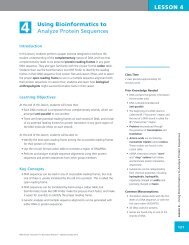WET LAB DNA Barcoding: From Samples to Sequences - Northwest ...
WET LAB DNA Barcoding: From Samples to Sequences - Northwest ...
WET LAB DNA Barcoding: From Samples to Sequences - Northwest ...
Create successful ePaper yourself
Turn your PDF publications into a flip-book with our unique Google optimized e-Paper software.
<strong>WET</strong> <strong>LAB</strong><br />
CLASS SET<br />
11. Centrifuge (or “spin”) your tube at 10,000 revolutions per<br />
minute (rpm) for one minute. See “How <strong>to</strong> Load <strong>Samples</strong> in a<br />
Microcentrifuge” for more information.<br />
We are using the centrifugal force of the centrifuge <strong>to</strong> push all of<br />
the cell debris, like the membranes, organelles, and proteins, <strong>to</strong> the<br />
bot<strong>to</strong>m of the microfuge tube. Your <strong>DNA</strong> will be in the liquid, or<br />
supernatant, above the cell debris found in the pellet, as seen in<br />
Figure 1.2. [Note: If your centrifuge doesn’t go as fast as 10,000<br />
rpm, centrifuge on maximum speed for 5 minutes.]<br />
Centrifugal force: The apparent<br />
force that seems <strong>to</strong> pull an object<br />
outward when the object is<br />
spun around in a circle. This is<br />
the force that creates a pellet in<br />
the bot<strong>to</strong>m of a microfuge tube<br />
during centrifugation, or forces<br />
material through a spin column.<br />
Supernatant: After<br />
centrifugation, the supernatant is<br />
the liquid found above the pellet.<br />
Pellet: After centrifugation, the<br />
pellet is the material found at the<br />
bot<strong>to</strong>m of the tube.<br />
Figure 1.2: Spinning the Microfuge Tube Separates the Supernatant <strong>From</strong> the Pellet.<br />
12. When you are done “spinning,” handle the microfuge<br />
tube very gently so that you don’t dislodge any pellet<br />
of insoluble debris at the bot<strong>to</strong>m of the tube. Hold the<br />
tube at eye level <strong>to</strong> see if you have a pellet. If you don’t<br />
have a pellet of debris at the bot<strong>to</strong>m of your tube, that<br />
is a good sign that your tissue is completely lysed!<br />
Using Bioinformatics: Genetic Research<br />
13. Obtain a spin column and a no-cap collection tube<br />
from your teacher.<br />
Spin columns contain a tiny piece of material in the<br />
bot<strong>to</strong>m that binds <strong>to</strong> your <strong>DNA</strong>. This holds the <strong>DNA</strong> in the<br />
column while the rest of the liquids wash away in<strong>to</strong> the<br />
collection tube. The liquid that passes through the columns<br />
is called the flow-through. Spin columns are often placed<br />
in no-cap collection tubes <strong>to</strong> collect the flow-through<br />
before discarding it. No-cap collection tubes are essentially<br />
microfuge tubes with the lids cut off, so the lids won’t<br />
get in your way. Be careful when handling the spin<br />
column and no-cap collection tube as they are not<br />
attached <strong>to</strong> each other (as seen in Figure 1.3).<br />
Figure 1.3: Spin Columns are Placed in No-cap Collection Tubes.<br />
352<br />
©<strong>Northwest</strong> Association for Biomedical Research—Updated Oc<strong>to</strong>ber 2012
















